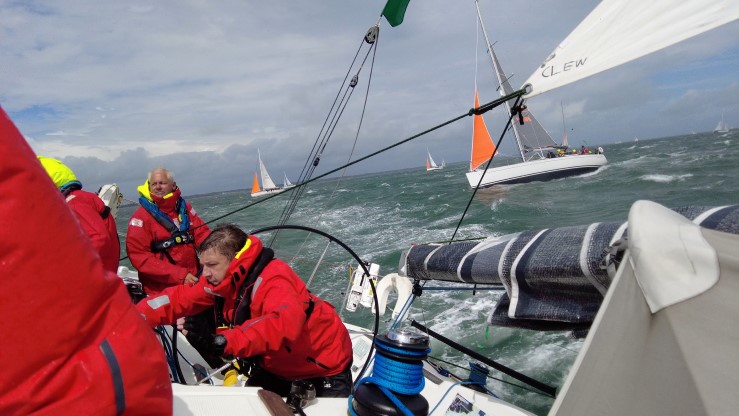Trio of action shots win RYA Midlands photography competition

RYA Midlands is pleased to announce that the overall winner of its ‘Photo February’ competition is David Eberlin with his picture of 420 youth sailors enjoying a race at Notts County Sailing Club.
The competition invited members of clubs and centres in the Midlands to share their pictures of people enjoying getting afloat either within the region or further afield while ‘on tour’ for racing or cruising.
David’s winning photograph caught the eye of our judges from the RYA Midlands Regional Volunteer Team, who described it as a fantastic ‘action on the water' shot: “The subjects are in focus and the background blurred, wonderful composition. The two young women are having fun racing and from a technical standpoint are sailing the boat perfectly flat.”
A committee member and Training Principal at Notts County SC, David will now be starting the new season in style with his prize of a Helly Hansen Scout Duffel (L) kit bag. As a keen amateur photographer, David took the photograph in April 2021, when the club returned to play following the easing of Covid pandemic restrictions, using a Canon R5 camera with an RF 600mm f11 lens.
He said: “It was just after lockdown was lifted and racing could restart. Ellie Rush is helming with Martha Christensen crewing and obviously they are enjoying the ride in their 420. It was a cool windy day but sunny and exhilarating, I actually took the photo from the bank with a 600mm lens as safety was a little busy! I often go in a boat as it is normally more interesting, you can get closer, but as it happened this day the sun was in the right position and the boats were beating directly towards us on the shore.”
This year’s Photo February competition also awarded prizes for two runners-up, who will each receive a Helly Hansen Ocean Dry Bag (XL): Roisin Ni Chonghaile from the Heart of England Offshore Cruising Association (HOEOCA) and Yi Zhang from Midland Sailing Club in Birmingham.

Roisin Ni Chonghaile from the Heart of England Offshore Cruising Association took her photograph at the start of the 695-mile Rolex Fastnet Race 2021 using an DJI Osmo Pocket 2 camera. Roisin was one of 10 on board the First 40.7 yacht chartered for the race by HOEOCA and captured the team in action as the fleet got underway with extreme conditions testing both racing and seamanship skills.
She said: “It was a Force 7-8 and it remained breezy for the first 24 to 36 hours of the race before it calmed down. Some boats stopped for a bit, some didn’t get over the startline and some didn’t finish, but we stayed away from the crowd and kept going with our storm sails up. The race is a marathon not a sprint, and we’re not spring chickens, so it’s an achievement taking part and we finished in the top 100, which for a Midlands-based crew, we were really pleased with. We’ve done the Fastnet a number of times as a club since 2013 and this was our best club finish.”
As the judges summed up when selecting Roisin’s picture: “Real action from one of the world’s most challenging races. The helm’s composure belies the fact that a great deal is happening around the boat.”

Yi Zhang is a keen photographer and member of Midland SC where his two boys first started enjoying watersports in 2021 and when entering Photo February said: “The club and the reservoir have been a blessing to the family. The boys have learned and enjoyed themselves so much since they started windsurfing and sailing last April.”
His winning photograph of windsurfers at the club was taken using a Panasonic LUMIX G5 and commenting on the striking composition, the judges said: “Two windsurfers travelling in opposite directions in perfect balance… the image reveals a butterfly and the symmetry must have been very difficult to achieve – or perhaps just good luck.”
Yi explains: “It was on a cold wintery Saturday last November after the snow… we organised a general drop in windsurfing session for both adults and juniors. Despite the cold snowy windy weather, we had a good turnout with 7 kids and 6 adult windsurfers. I was helping Natalia our windsurfing coach on the powerboat when this photo was taken. As you can see, the wind was changing all the time, hence I had the opportunity to see a ‘butterfly’ composition.”
Celebrating time on the water
The RYA Midlands Photo February competition took place for the first time last year during lockdown three and invited participants to look back through their albums, or take snaps while out walking for daily exercise. The aim of this year’s second edition was to celebrate the return to activities which followed, with entries highlighting the fantastic variety of ways in which people had fun getting back afloat.
RYA Regional Volunteer Team chair Steven Tinsley said: “The challenge as before was selecting photographs that firstly met the brief while also showing scenes of boating with exciting and engaging content and importantly, of course, people just simply enjoying their time on the water.
“To make judging even more challenging, this year we had a really diverse mixture of craft: windsurfing, wing foiling, foiling windsurfers, dinghy sailing and racing, yachting and narrow boating, plus some absolutely stunning atmospheric scenes from our clubs around the region.
“We were completely bowled over by the quality of the images. It seems that this year the photographers were determined to get the best possible shots of activity on the water, well done to all who contributed.”
Look out for the return of the RYA Midlands Photo February competition next year!
